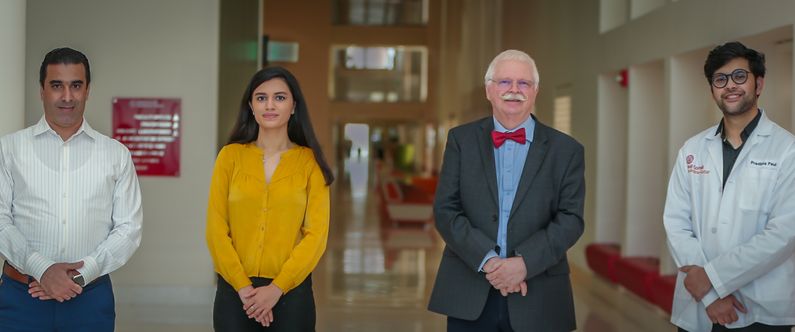WCM-Q student researchers highlight the effects of flavonoids on COVID-19
 From left: WCM-Q researchers Dr. Ali Chaari, student Ridhima Kaul, Dr. Dietrich Büsselberg, and student Pradipta Paul investigated the potential of naturally occurring plant compounds to fight viral infections such as SARS-CoV-2, the virus that causes COVID-19.
From left: WCM-Q researchers Dr. Ali Chaari, student Ridhima Kaul, Dr. Dietrich Büsselberg, and student Pradipta Paul investigated the potential of naturally occurring plant compounds to fight viral infections such as SARS-CoV-2, the virus that causes COVID-19.
Student researchers at Weill Cornell Medicine-Qatar (WCM-Q) contributed to a study investigating the potential of flavonoids found in plants for fighting viral infections such as SARS-CoV-2, the virus that causes COVID-19.
Under the guidance of WCM-Q mentors, medical students Ridhima Kaul and Pradipta Paul conducted a systematic review of 27 existing research papers to determine the effectiveness of 69 different flavonoids against various SARS-CoV-2 drug targets, including ‘3C-like protease’, an enzyme with a key role in replication of the virus.
The study, which is published in the International Journal of Molecular Sciences, found that several flavonoids showed promising antiviral properties, including quercetin (found in onions, apples, berries and green tea), myricetin (found in tomatoes, oranges, nuts, various herbs, berries, and tea), and tannic acid (found in black garlic extract).
The students were mentored by Dr. Ali Chaari, assistant professor of biology, and Dr. Dietrich Büsselberg, professor of physiology and biophysics, and assistant dean for admissions.
Dr. Chaari said: “Mentoring curious students is important to create opportunities for them to discover the research domain. I was happy to mentor two of our outstanding students, Ridhima Kaul and Pradipta Paul, and to celebrate their success, not only in science but also as future model doctors undertaking research and exemplifying the key attributes of hard work, professionalism, and excellent critical thinking and time management skills.”
Although multiple vaccines have been developed and administered around the globe, newer mutated strains of the virus and the lack of lasting, universal immunity initiated a shift in focus to therapeutic treatments for the disease, which prompted the research paper. Flavonoids are natural phytochemicals (compounds produced by plants). They presented themselves as promising medications given their success during in silico, in vitro, and in vivo studies against SARS-CoV-2 and other viruses.
Of the flavonoids studied, quercetin showed the most potential and has the most encouraging results to date, even showing promise in clinical trials. However, the study notes that the tendency of flavonoids to aggregate rather than disperse through an organism, plus their limited bioavailability diminish their effectiveness as therapeutic interventions. While the use of flavonoids in combination with synthetic and commercially produced drugs is promising, more research is needed to prove their synergistic effects. Nonetheless, given the growing concerns of antiviral resistance, the study concludes that naturally occurring flavonoids are a promising alternative.
Second-year medical student Ridhima Kaul said: “With more than 5 million lives lost to COVID-19 despite emergency vaccines, the need for therapeutic interventions has been very evident. Amidst this crisis, flavonoids, a large group of compounds with proven therapeutic efficacy against multiple viruses of concern, have shown promise in this regard and are consequently the focus of our analytic work. We are extremely excited about the publication of this paper and would like to thank our mentors Dr. Chaari and Dr. Büsselberg, for their continued support and guidance. I hope our work contributes a small step towards combatting the pandemic around the globe.”
First-year medical student Pradipta Paul said: “Our review is unique in providing an analysis of the structure-activity relationships of flavonoids and reviewing ongoing and completed clinical trials - we have widened the scope of our paper to attract both pharmaceutical researchers as well as healthcare providers. This paper is part of a wider project with Dr. Ali Chaari where we study the effects of flavonoids, nutraceuticals, and other small molecules on infectious and metabolic diseases.”
Other researchers who contributed to the study were Vivek Dhar Dwivedi of the Pathfinder Research and Training Foundation (PRTF) in Utter Pradesh, India, and Sanjay Kumar of PRTF and the School of Biotechnology at Jawaharlal Nehru University, New Delhi.
Dr. Chaari said: “This publication is one in a series of investigations based on a multi-targeted approach that aims at mentoring students. This approach provides students with a great opportunity to acquire different skills in a variety of fields, including biochemistry, molecular biology, biophysics, as well providing an introduction to artificial intelligence in pharmacology, drug design and screening. Mentoring students on research skills contributes to their lifelong education.”
The research team chose to publish the paper in an open-access journal to facilitate collaborations with other researchers and to provide developers of pharmaceutical products with a freely accessible information resource about flavonoids with potential therapeutic applications.
To read the paper in full, titled Promising Antiviral Activities of Natural Flavonoids against SARS-CoV-2 Targets: Systematic Review, visit https://www.mdpi.com/1422-0067/22/20/11069